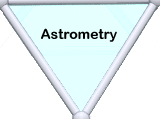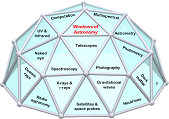Windows of Astronomy |
|
Neutrinos The idea of a neutrino was originated by Wolfgang Pauli in 1930 and the name coined by Enrico Fermi a couple of years later. It was conceived as a particle with no charge and probably zero rest mass that would carry away energy in radioactive beta decay. When particle physics came of age later in the century it was realised that neutrinos fitted very naturally into the bigger scheme of things. There were neutrinos and anti-neutrinos; three different kinds corresponding to three variants of beta decay. Once created, though, they hardly interact with matter at all. The Earth itself is almost completely transparent to neutrinos. What has made detection possible is the vast number produced in the underlying process of nuclear fusion that powers the Sun and the processes of nuclear fission and decay that take place in reactors. Given neutrinos in vast numbers, a few will be detected. Frederick Reines was awarded a share of the 1995 Nobel Prize in Physics "for the detection of the neutrino". Neutrino astronomy means chasing rare events – the capture of a neutrino by an atom followed by its distinctive transmutation that ends with a characteristic pulse of radiation being emitted. It is the radiation that is detected. Neutrinos are produced by all stars in their normal fuel-using capacity; there is a residual cosmological background of neutrinos (not experimentally detected) originating from the ‘big bang’ and neutrinos are produced in violent events such as supernovae explosions. Neutrino ‘telescopes’ are typically located deep underground, or underwater, or in Antarctica under the ice, to shield them from detecting cosmic ray induced events. Their first extremely useful function was to confirm (eventually) that the standard model describing how the Sun produced its energy correctly predicts the number of solar neutrinos observed. Neutrino astronomy aiming to provide more information on extreme events in the universe is a developing arena in the 21st century. Because of the rarity of neutrino detection, it will be a subject that develops slowly.
|
 The detecting array at the Sudbury Neutrino Observatory more than 2 km below ground. Note the size of the person in the gallery. Arthur McDonald working here shared the 2015 Nobel Prize in Physics "for the discovery of neutrino oscillations, which shows that neutrinos have mass". The detecting array at the Sudbury Neutrino Observatory more than 2 km below ground. Note the size of the person in the gallery. Arthur McDonald working here shared the 2015 Nobel Prize in Physics "for the discovery of neutrino oscillations, which shows that neutrinos have mass". |


